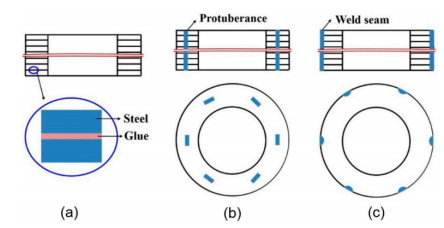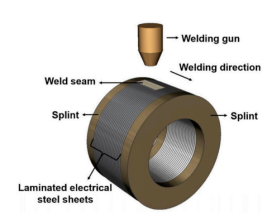With the rapid development of electric vehicles, wind power, and rail transportation, motors today are expected to deliver higher efficiency, lower energy losses, and greater reliability. At the heart of every motor lies its laminated core, typically built from layers of silicon steel sheets. But how these sheets are joined together plays a crucial role—not only in mechanical integrity but also in key performance metrics like electromagnetic efficiency, heat dissipation, and noise control.
This article explores the three mainstream core joining techniques—adhesive bonding, mechanical fastening, and fusion welding—breaking down their working principles, advantages, technical challenges, and the evolving trends shaping their future.

I. Overview of Core Joining Methods
Motor core joining methods generally fall into three categories, each with distinct use cases and performance characteristics:
 Schematic diagram of representative lamination core joining methods
Schematic diagram of representative lamination core joining methods
1. Adhesive Bonding
Adhesive bonding uses insulating glue to bind silicon steel laminations together. This modern technique is gaining ground in high-end drive motors due to its ability to:
-
Preserve insulation coatings and reduce core losses
-
Enhance structural rigidity, lowering noise and vibration
-
Support high-speed, high-frequency motor applications by minimizing eddy currents
However, it also comes with challenges:
-
Requires strict control over lamination thickness and surface cleanliness
-
Demands glues with excellent insulation, heat resistance, and environmental compliance
-
Involves complex curing procedures needing precise temperature and timing control
Leading manufacturers are already incorporating adhesive bonding in EV drive systems and industrial servo motors, supported by advances in automation and glue material technologies.
2. Mechanical Fastening
Traditional mechanical fastening—via rivets, clips, or pins—remains prevalent in household appliances and small motors due to:
-
Low cost and suitability for mass production
-
Easy assembly/disassembly and maintenance
-
Minimal reliance on adhesives or complex equipment
Yet, this approach has limitations:
-
Rivets or pins may degrade magnetic performance and reduce efficiency
-
Localized stress can deform the core stack, compromising mechanical consistency
-
Requires highly consistent punching quality and dimensional tolerances
Improvements in material selection and tooling design are ongoing to mitigate these drawbacks and improve reliability.
3. Fusion Welding
Fusion welding, a permanent joining method, is commonly used in large, high-load motors. It uses heat to locally melt and bond silicon steel laminations, offering:
-
High structural stiffness and vibration resistance
-
Lighter overall weight with no extra fastening parts
-
Compatibility with complex or custom core shapes
The main downside is that the heat-affected zone can degrade magnetic properties:
-
Local annealing or grain growth increases core losses
-
Weld seams may become stress concentrators prone to fatigue
-
Demands tight control over welding parameters and material stability
To counteract these effects, techniques like post-weld annealing and optimized seam design are actively being adopted.
II. How Joining Affects Electromagnetic Performance
Each joining method influences motor performance differently:
-
Core Losses: Adhesive bonding reduces eddy current paths, particularly beneficial in high-frequency applications
-
Magnetic Flux Uniformity: Mechanical fasteners can introduce non-magnetic zones, disrupting flux flow
-
Thermal Stability: Welded cores perform better at high temperatures but risk magnetic degradation
-
Noise & Vibration: Bonded cores offer better NVH (Noise, Vibration, Harshness) performance due to uniform rigidity
The ideal joining solution depends on the motor's application—for instance, high-speed motors prioritize low core loss and high strength, while industrial motors operating at standard frequency focus on cost and assembly efficiency. The choice requires careful balancing of performance, cost, and process maturity.
III. Trends and Innovations in Core Joining
Looking ahead, motor core joining will evolve along several key directions:
-
Advanced Adhesives: New eco-friendly epoxies and solvent-free glues will enhance reliability and support automated processing
-
Modular Hybrid Structures: Combining mechanical and adhesive techniques will offer higher consistency, reliability, and serviceability
-
Laser Welding: Compared to resistance welding, laser welding delivers higher precision with less thermal impact, ideal for automated and complex designs
-
Intelligent Process Control: Sensors and digital process models will enable real-time monitoring and feedback, ensuring consistency and quality
 Schematic diagram of laser welding for laminated cores
Schematic diagram of laser welding for laminated cores
As new materials, AI, and smart manufacturing converge, motor core joining is transforming into a multidisciplinary engineering domain—no longer just about glue or welds, but a full system optimization.
At MOOPEC, we support this transformation by providing high-performance silicon steel and precision processing services for motors, transformers, and generators. Our capabilities span slitting, punching, core lamination, and small-batch prototyping. Driven by our "Coil-to-Core" model, we help clients achieve faster turnaround, higher consistency, and superior core performance—serving a broad range of industries including EVs, wind power, railway systems, and distribution grids.
If you're facing challenges in material selection, core joining, or process integration, MOOPEC is ready to assist with technical expertise and responsive support.
As a critical step in motor manufacturing, core joining directly affects motor performance, stability, and service life. Facing diverse demands and rising quality standards, researchers and manufacturers must continue innovating across materials, processes, equipment, and intelligent controls. This holistic approach will drive motor core joining into a more reliable, efficient, and sustainable future—powering the next generation of electric machines.